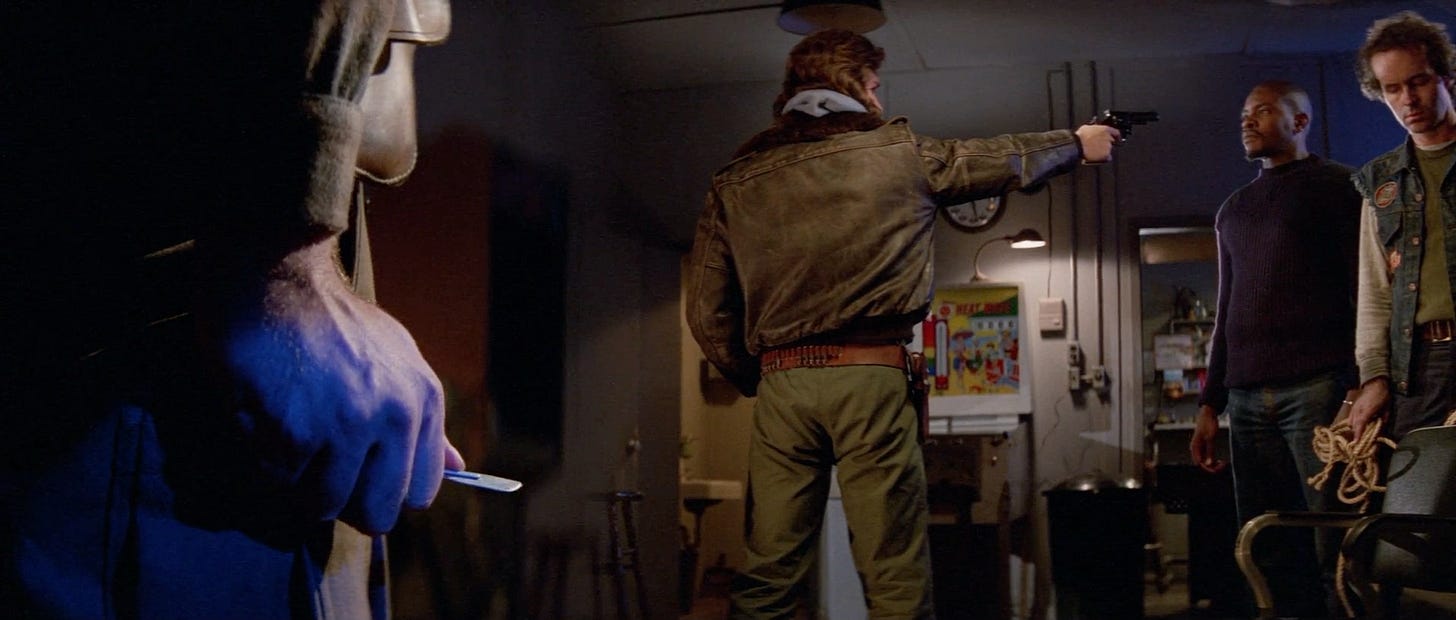Visual Tension and Split Diopters in THE THING
How can you use split diopters to create visual tension?
“We made the frame claustrophobic and used it to confine the characters.”
— Director of Photography: Dean Cundey, ASC1
The Thing (1982) is a fantastic paranoid thriller just as much as it is a fantastic sci-fi horror. The masterful use of camera movement and composition builds the intensity of the entire film throughout its run time.
In the film’s second half, the filmmakers start using split diopter shots — shots that have multiple planes in focus — to really create that sene of claustrophobia and make the audience physically feel the tension.
The video above shows those shots back-to-back. But there’s value in looking at them in context with some additional notes (I hope!)
Scene 1 - MacReady and Fuchs
Here, MacReady (Kurt Russell) has a brief exchange with Fuchs (Joel Polis) over their shared suspicions.
The split diopter is efficient. This scene is only two setups: the wide of MacReady and Fuchs, and the single back onto Fuchs. There is no tighter shot(s) of MacReady.
Both areas of focus are exposed to a similar level. They are equal in the visual hierarchy.
Images in Western cinema tend to be composed to be read left-to-right because our written language is left-to-right.
In this shot, our eyes take a moment to scan the image (left to right) before coming to rest on Fuchs (who is the biggest thing in frame) as the main point of interest—
And then MacReady enters on screenLeft, startling us and Fuchs!
With the reverse back onto Fuchs, note how the eyeline is so fore-shortened, with a big amount of negative space on screenRight. The composition feels unbalanced and so we feel unbalanced (like Fuchs!)
Scene 2 - MacReady with the dynamite!
MacReady has freed himself loose of his bonds and has broken himself back into camp, threatening to blow himself - and the base - if anyone attacks him. Meanwhile, the doctor performs CPR on Norris who has appeared to have a heart attack.
Unseen by anyone, Clark grabs a scalpel.
Note how the coverage tends to point up towards the ceiling or down towards the floor: the camp/envrionment itself is trapping these men.
The split diopter shot is framed to make MacReady centre-frame. Our eyes are drawn to him as he is flanked on all sides. We feel his entrapment.
To ensure we notice the scalpel, there is a hard light source setup so it glints in frame — drawing our eye.
This setup is used twice in this scene. The same idea (of using the split diopter twice) is used in the following scene when Clark, once again, pulls out the scalpel.
Scene 3 - MacReady confronts Childs
In this scene, MacReady has proposed a test to see who is the titular thing.
Clark appears to agree with MacReady, but the split diopter shot shows us that he doesn’t trust MacReady - he’s got the scalpel ready! And when MacReady’s back is turned, he goes for it.
There’s some great direction here:
The way the camera tracks and pans as Clark physically gets closer to MacReady. It feels both threatening yet also engaging.
The way the split diopter shot is a callback to the previous scalpel shots! MacReady centre frame, the scalpel at the ready in screen left (note the use of blue to help contrast it and draw our eye).
But I’m especially keen on this little moment where MacReady confronts Childs:
MacReady walks towards camera and that momentum is transferred into a reverse: a dolly that follows the gun as it appears into frame and singles out Childs. It is so threatening and makes us feel like WE are the threat.
Clark makes his move and MacReady responds instinctively, killing him. While not a split diopter shot, the widescreen frame has similar compositional elements and lets us see everyone’s reaction to Clark’s death:
Scene 4 - The Wire Test
Last is this scene, where MacReady is about to administer his test.
The scene does an excellent job of building tension by witholding visual information. We start close, the camera pans across all the men, and only at the end do we reveal the geography of the whole scene. MacReady may have emerged as a leader - literally standing above all the others - but he’s also seperate from them.
Any other observations on THE THING? Leave a comment!
IMDB
Dean Cundey, ASC on Photographing The Thing via: https://theasc.com/articles/flashback-the-thing









